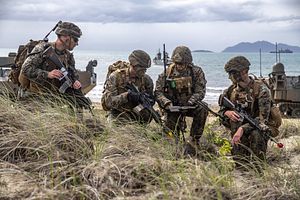Marines of the Japan Ground Self Defense Force’s (JGSDF) new Amphibious Rapid Deployment Brigade (ARDB), alongside U.S. Marines and Australian naval infantry, conducted a beach raid exercise and a separate beach landing, next to other operations, during this year’s Talisman Sabre exercise, according to the U.S. Department of Defense (DoD).
The bilateral United States-Australia Talisman Sabre military exercise (TS19) took place between July 7 and 27 in the Australian Defense Force’s Shoalwater Bay Military Training Area off the coast of Queensland, Australia. For the first time, Japan Self-Defense Force (JSDF) troops were invited to participate in the biannual exercise as trilateral U.S.-Japan-Australia military cooperation has expanded in recent years.
U.S. Marines, Australian service members, and elements of the ARDB jointly conducted “an integrated air campaign, combined forcible entry operations, amphibious raids, and High Mobility Artillery Rocket System (HIMARS) Rapid Insertion (HIRAIN),” according to the DoD press release. This included beach landings at Stanage Bay and near Bowen, a coastal town in eastern Queensland, Australia.
“The fact that U.S. Marines, the Australian Army and [the JSDF] conducted an amphibious combined joint forcible entry into the same objective area here during Talisman Sabre cannot be [overstated],” Major Mike Mroszczak, operations officer with the 31st U.S. Marine Expeditionary Unit, said in a news release.
“Talisman Sabre 19 was an excellent exercise that allowed us to work with, display, and refine our skills working with the Australian Amphibious Task Group and the Japan Amphibious Rapid Deployment Brigade as a multi-national amphibious force,” said Colonel John Medeiros, the assistant chief of staff for operations of the 3rd U.S. Marine Division. “It offered us the ability to demonstrate interoperability between three allied nations into a combined landing force while improving and enhancing our operational capabilities.”
Japan’s ARDB, stood up in April last year, currently consists of around 2,000 troops, a number that is expected to increase to 3,000 in the coming years. The Western Army Infantry Regiment, based in Sasebo in Nagasaki prefecture, has served as the nucleus of this new force. The ARDB has been placed under the Japan Ground Self-Defense Force Ground Component Command, which was established in March 2018.
The main mission of the ARDB is the defense of the 6,000 islands and islets of the Ryukyu Islands chain, which stretches southwest from Kyushu to Taiwan. The unit currently lacks a sufficient number of operational Assault Amphibious Vehicles 7s and there have also been delays in the induction of V-22 Ospreys. Around 300 members of the ARDB took part in the drills.
Notably, a Chinese warship reportedly monitored parts of this year’s TS19 exercise.

































